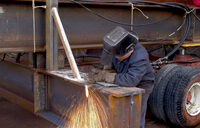Y our manufacturing plant has all the right safety equipment and training procedures in place. Why do you keep having accidents? The answer is simple: you have humans involved. Human error can negate even the most stringent safety measures. However, there are steps you can take to reduce this vast area for mistakes.
our manufacturing plant has all the right safety equipment and training procedures in place. Why do you keep having accidents? The answer is simple: you have humans involved. Human error can negate even the most stringent safety measures. However, there are steps you can take to reduce this vast area for mistakes.
Training and enforcement
Employee attitudes of skipping a safety step because “the job will only take one minute” must be nipped in the bud. This is a critical point of human error. Your employee only needs to drill one hole — why bother putting on safety glasses? The repair only involves a quick belt replacement — why bother shutting the power off? These human errors lead to accidents.
The end of the workday presents a crucial time for errors. Tired workers do not want to take the five extra minutes to put a chemical away safely, because it’s already time to go home. But the next morning, you may face a plant filled with dangerous or explosive fumes.
To prevent end-of-day errors, make sure that cleanup time is included as part of the workday. This may mean shutting production down five minutes earlier than normal. Workers that do not have clean up or put away jobs to perform can assist those that do. While an extra 25 minutes a week does cut into tight production schedules, consider how much time is lost if your entire plant has to shut down because of an accident.
Enforcement of safety must come from the top of your facility and work its way down. This means that you, and all supervisors and upper management, must follow the safety guidelines you have established. Your workers are looking at your actions. If you don’t care, they will not be motivated to follow the guidelines.
Safe and practical
The human factor again comes into play when it comes to the personal protective equipment (PPE) you provide your workers. You have trained them in all required safety procedures, and in how to use their safety equipment. The cut-resistant gloves are sitting on the bench along with the safety glasses.
Now you need to get to the root of the problem. The gloves you have provided may be too tight, too loose or just plain uncomfortable. Your employees’ hands may sweat too much, leaving workers miserable at the end of the day.
Similar problems exist with safety glasses and other equipment. The glasses may block an employee’s vision or rub the skin on their nose, ears or head. Just because safety equipment is engineered to work, it does not mean it is comfortable. If this is the problem, you need to look for answers to make the PPE work properly.
Zero-tolerance policy
Controversy surrounds this topic — what your employees do on their own time is their business. But no one should be permitted to work under the influence of alcohol or illegal substances. This is a given. The problem occurs when employees’ off-hours behavior rolls over into the workday.
If a worker spent the weekend on an alcohol or drug-fueled binge, that worker is not likely to be capable of working at full performance. In addition, if an accident does occur, substance tests are normally mandatory. Alcohol or drug use can trigger a response even hours later. You must make your employees aware of work policies and the ramifications of off-duty behaviors.
You should also recognize that employees that come into work when they are ill present more than just a contamination hazard to other workers. The common cold or flu can reduce a worker’s reflexes and response time. Cold medications may make an employee drowsy.
You company should provide some sick time — if not, at least allow workers to stay home if they are too ill to work. You do need to balance the true need with those that abuse the policy. However, you are better off when sick employees are not operating equipment.
You will always face the reality of human error defeating safety. If you recognize where these mistakes can happen, you have a much better chance of keeping human error under control.
Author bio:
Christina Chatfield is Marketing Communications Manager of HARTING USA in Elgin, IL. HARTING USA rectangular connectors and electrical cables are developed, manufactured and supplied by the company for your industrial manufacturing needs.